On August 8, at Chiba University of Commerce, a press-open FD (Faculty Development) "Looking back on distance lessons in the spring semester and the possibility of distance lessons" was held by Zoom distribution. FD is an activity that teachers systematically carry out to improve and improve appropriate lesson content and methods.There are various methods such as class evaluation questionnaires for students and study groups on class methods, but this is a rare attempt because it is usually held privately.
Utilizing the reflection of the spring semester for distance learning in the fall semester
At Chiba University of Commerce, all the spring semesters of 2020 have been conducted by distance learning as a countermeasure against the new coronavirus. In the fall semester from October, due to the tendency of the number of infected people to increase again, it has been decided that some subjects such as seminars will be conducted in interview classes (commuting to school), and other subjects will be conducted in distance classes.
Therefore, during the summer vacation, all the faculty members will conduct a student questionnaire to promote "further improvement of the quality of distance learning in the fall semester" and "examination of educational methods using ICT tools that encourage active learning by students". It was said that the FD was carried out by reporting and analyzing the results of the study and introducing case studies of distance learning in the spring semester.
Evaluation of distance learning as seen in "Student Questionnaire Results and Analysis"
The Academic Affairs Division reported the results of two student questionnaire items.Item 2 is "About the entire distance lesson in the spring semester," which surveys the student's lesson environment and the satisfaction and problems of each lesson method. The response rate is 1% for first graders, 1% for second graders and above, and item 91.7 is remote. The response rate for the "Class Evaluation Questionnaire" at the end of the semester, which was conducted as a question for class, was 2% for all grades.
Notable results are the implementation status and satisfaction of distance learning in item 1.For example, in the comparison of A (text material distribution), B (voice distribution), C (video distribution), D (real-time distribution) and 4 methods, B is the most and C is the least number, but in the evaluation of the method The best was C.


Although there are differences in each method, 70.9% of all methods gave a positive answer on average.The reasons for the free description were that the good ones were "you can check the materials as many times as you want until you understand them", and the bad ones were "many issues" in common with the method.
In addition, in item 2, "Class Evaluation Questionnaire," the average satisfaction level for all subjects was 88.34%, even though it was a spring semester centered on distance learning.It seems that it was highly evaluated, not much different from 90.61% at the same time last year.
In addition to reflecting this result in the distance learning implementation guidelines, the university also distributes to faculty members the points to keep in mind for each lecture format and method, centered on the members of the information system.In addition, along with sharing typical questions from students, proposals were made from the perspective of academic affairs, including points to keep in mind during the first class and consideration for smartphone students to submit their assignments.
- 1
- 2
